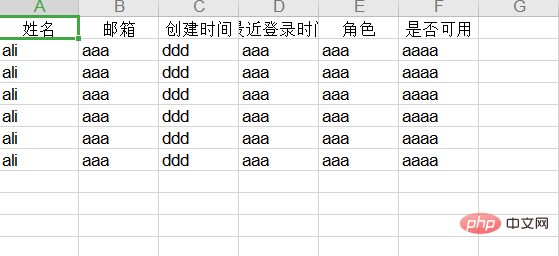
The implementation method is as follows:
(Video tutorial recommendation: java course)
1. First create a new SpringBoot project
2. Import dependencies –pom.xml
<?xml version="1.0" encoding="UTF-8"?>
<project xmlns="http://maven.apache.org/POM/4.0.0" xmlns:xsi="http://www.w3.org/2001/XMLSchema-instance"
xsi:schemaLocation="http://maven.apache.org/POM/4.0.0 https://maven.apache.org/xsd/maven-4.0.0.xsd">
<modelVersion>4.0.0</modelVersion>
<parent>
<groupId>org.springframework.boot</groupId>
<artifactId>spring-boot-starter-parent</artifactId>
<version>2.2.6.RELEASE</version>
<relativePath/> <!-- lookup parent from repository -->
</parent>
<groupId>com.briup</groupId>
<artifactId>demo3</artifactId>
<version>0.0.1-SNAPSHOT</version>
<packaging>war</packaging>
<name>demo3</name>
<description>Demo project for Spring Boot</description>
<properties>
<java.version>1.8</java.version>
</properties>
<dependencies>
<dependency>
<groupId>org.springframework.boot</groupId>
<artifactId>spring-boot-starter-web</artifactId>
</dependency>
<dependency>
<groupId>org.springframework.boot</groupId>
<artifactId>spring-boot-starter-tomcat</artifactId>
<scope>provided</scope>
</dependency>
<dependency>
<groupId>org.springframework.boot</groupId>
<artifactId>spring-boot-starter-test</artifactId>
<scope>test</scope>
<exclusions>
<exclusion>
<groupId>org.junit.vintage</groupId>
<artifactId>junit-vintage-engine</artifactId>
</exclusion>
</exclusions>
</dependency>
<dependency>
<groupId>org.apache.poi</groupId>
<artifactId>poi</artifactId>
<version>3.6</version>
<exclusions>
<exclusion>
<groupId>javax.servlet</groupId>
<artifactId>servlet-api</artifactId>
</exclusion>
<exclusion>
<groupId>log4j</groupId>
<artifactId>log4j</artifactId>
</exclusion>
</exclusions>
</dependency>
</dependencies>
<build>
<plugins>
<plugin>
<groupId>org.springframework.boot</groupId>
<artifactId>spring-boot-maven-plugin</artifactId>
</plugin>
</plugins>
</build>
</project>3. Create various classes
New entity class
Remember to add get/set methods
public class User {
private String username;
private String email;
private String createTime;
private String LastLoginTime;
private String roleName;
private String enable;
public User() {
super();
}
}Create a new interface Service
import java.util.List;
public interface UserService {
public List<User> findAllUser();
}Create a new Impl that implements the Service interface
import java.util.List;
public class UserServiceImpl implements UserService {
@Override
public List<User> findAllUser() {
User user = new User();
return null;
}
}Create a new ExcelUtil tool class
import java.util.List;
import java.util.Map;
import org.apache.poi.hssf.usermodel.HSSFCell;
import org.apache.poi.hssf.usermodel.HSSFCellStyle;
import org.apache.poi.hssf.usermodel.HSSFRow;
import org.apache.poi.hssf.usermodel.HSSFSheet;
import org.apache.poi.hssf.usermodel.HSSFWorkbook;
public class ExcelUtil {
public static HSSFWorkbook getHSSFWorkbook(String sheetName,String sheetName1,String sheetName2, String []title, String[] content,String[] app){
// 第一步,創(chuàng)建一個(gè)HSSFWorkbook,對(duì)應(yīng)一個(gè)Excel文件
HSSFWorkbook wb = new HSSFWorkbook();
// 第二步,在workbook中添加一個(gè)sheet,對(duì)應(yīng)Excel文件中的sheet
HSSFSheet sheet = wb.createSheet(sheetName);
HSSFSheet sheet1 = wb.createSheet(sheetName1);
HSSFSheet sheet2 = wb.createSheet(sheetName2);
// 第三步,在sheet中添加表頭第0行,注意老版本poi對(duì)Excel的行數(shù)列數(shù)有限制
HSSFRow row = sheet.createRow(0);
HSSFRow row1 = sheet1.createRow(0);
HSSFRow row2 = sheet2.createRow(0);
// 第四步,創(chuàng)建單元格樣式,并設(shè)置值表頭 設(shè)置表頭居中
HSSFCellStyle style = wb.createCellStyle();
style.setAlignment(HSSFCellStyle.ALIGN_CENTER); // 創(chuàng)建一個(gè)居中格式
//聲明單元格
HSSFCell cell = null;
//創(chuàng)建標(biāo)題
for(int i=0;i<title.length;i++){
//創(chuàng)建一個(gè)單元格
cell = row.createCell(i);
//給單元格賦值
cell.setCellValue(title[i]);
//給單元格設(shè)置樣式
cell.setCellStyle(style);
}
//創(chuàng)建標(biāo)題
for(int i=0;i<title.length;i++){
//創(chuàng)建一個(gè)單元格
cell = row1.createCell(i);
//給單元格賦值
cell.setCellValue(title[i]);
//給單元格設(shè)置樣式
cell.setCellStyle(style);
}
//創(chuàng)建內(nèi)容
if (content != null && content.length > 0){
for(int i=0;i<content.length;i++){
row = sheet.createRow(i + 1);
for(int j=0;j<content.length;j++){
//將內(nèi)容按順序賦給對(duì)應(yīng)的列對(duì)象
row.createCell(j).setCellValue(content[j]);
}
}
}
if (content != null && content.length > 0){
for(int i=0;i<content.length;i++){
row1 = sheet1.createRow(i + 1);
for(int j=0;j<content.length;j++){
//將內(nèi)容按順序賦給對(duì)應(yīng)的列對(duì)象
row1.createCell(j).setCellValue(content[j]);
}
}
}
if (app != null && app.length > 0){
for(int i=0;i<app.length;i++){
row2 = sheet2.createRow(i + 1);
for(int j=0;j<app.length;j++){
//將內(nèi)容按順序賦給對(duì)應(yīng)的列對(duì)象
row2.createCell(j).setCellValue(app[j]);
}
}
}
return wb;
}
}Create a new Controller class
import java.io.OutputStream;
import java.text.SimpleDateFormat;
import java.util.ArrayList;
import java.util.List;
import javax.servlet.http.HttpServletResponse;
import org.apache.poi.hssf.usermodel.HSSFWorkbook;
import org.springframework.util.StringUtils;
import org.springframework.web.bind.annotation.RequestBody;
import org.springframework.web.bind.annotation.RequestMapping;
import org.springframework.web.bind.annotation.ResponseBody;
import org.springframework.web.bind.annotation.RestController;
@RestController
@RequestMapping("/MyTest")
public class HelloController {
@ResponseBody
@RequestMapping("/hello")
public void export(@RequestBody(required = false) User user,String username,HttpServletResponse response) throws Exception {
if (user ==null && !StringUtils.isEmpty(username)){
//GET 請(qǐng)求的參數(shù)
user = new User();
user.setUsername(username);
}
UserService userService = new UserServiceImpl();
//獲取數(shù)據(jù)
List<User> list = userService.findAllUser();
//excel標(biāo)題
String[] title = {"姓名", "郵箱", "創(chuàng)建時(shí)間", "最近登錄時(shí)間","角色","是否可用"};
//excel文件名
String fileName = System.currentTimeMillis() + ".xls";
//sheet名
String sheetName = "用戶信息";
String sheetName1 = "hello";
String sheetName2 = "xixi";
//沒有數(shù)據(jù)就傳入null吧,Excel工具類有對(duì)null判斷
String[] content= {"ali","aaa","ddd","aaa","aaa","aaaa"};
String[] app= {"bbbb","bbbb","bbbb","bbbb","bbbb","bbbb",};
if (list != null && list.size() > 0){
SimpleDateFormat sdf = new SimpleDateFormat("yyyy-MM-dd");
for (int i = 0; i < list.size(); i++) {
User obj = list.get(i);
content[1] = obj.getUsername();
content[1] = obj.getEmail();
content[2] = obj.getCreateTime() == null ? "" : sdf.format(obj.getCreateTime());
content[3] = obj.getLastLoginTime() == null ? "": sdf.format(obj.getLastLoginTime());
content[4] = obj.getRoleName();
}
}
if (list != null && list.size() > 0){
SimpleDateFormat sdf = new SimpleDateFormat("yyyy-MM-dd");
for (int i = 0; i < list.size(); i++) {
User obj = list.get(i);
app[1] = obj.getUsername();
app[1] = obj.getEmail();
app[2] = obj.getCreateTime() == null ? "" : sdf.format(obj.getCreateTime());
app[3] = obj.getLastLoginTime() == null ? "": sdf.format(obj.getLastLoginTime());
app[4] = obj.getRoleName();
}
}
//創(chuàng)建HSSFWorkbook
HSSFWorkbook wb = ExcelUtil.getHSSFWorkbook(sheetName,sheetName1,sheetName2, title, content,app);
// HSSFWorkbook wb1 = ExcelUtil.getHSSFWorkbook(sheetName1, title, content);
//響應(yīng)到客戶端
try {
fileName = new String(fileName.getBytes(), "UTF-8");
response.setContentType("application/vnd.ms-excel;charset=utf-8");
response.setHeader("Content-Disposition", "attachment; filename=" + fileName);
OutputStream os = response.getOutputStream();
wb.write(os);
os.flush();
os.close();
} catch (Exception e) {
e.printStackTrace();
}
}
}Set application .properties
server.port=8081
The most important thing to note is: the Application class must be in the outermost package! ! !
4. The last visit to
localhost:8081/MyTest/hello
resulted:

did not write the front end, You can write an html, set an a tag, and click the event.
Related recommendations:Getting started with java
The above is the detailed content of Java implements exporting excel files. For more information, please follow other related articles on the PHP Chinese website!

Hot AI Tools

Undress AI Tool
Undress images for free

Undresser.AI Undress
AI-powered app for creating realistic nude photos

AI Clothes Remover
Online AI tool for removing clothes from photos.

Clothoff.io
AI clothes remover

Video Face Swap
Swap faces in any video effortlessly with our completely free AI face swap tool!

Hot Article

Hot Tools

Notepad++7.3.1
Easy-to-use and free code editor

SublimeText3 Chinese version
Chinese version, very easy to use

Zend Studio 13.0.1
Powerful PHP integrated development environment

Dreamweaver CS6
Visual web development tools

SublimeText3 Mac version
God-level code editing software (SublimeText3)

Hot Topics
 What is a Singleton design pattern in Java?
Jul 09, 2025 am 01:32 AM
What is a Singleton design pattern in Java?
Jul 09, 2025 am 01:32 AM
Singleton design pattern in Java ensures that a class has only one instance and provides a global access point through private constructors and static methods, which is suitable for controlling access to shared resources. Implementation methods include: 1. Lazy loading, that is, the instance is created only when the first request is requested, which is suitable for situations where resource consumption is high and not necessarily required; 2. Thread-safe processing, ensuring that only one instance is created in a multi-threaded environment through synchronization methods or double check locking, and reducing performance impact; 3. Hungry loading, which directly initializes the instance during class loading, is suitable for lightweight objects or scenarios that can be initialized in advance; 4. Enumeration implementation, using Java enumeration to naturally support serialization, thread safety and prevent reflective attacks, is a recommended concise and reliable method. Different implementation methods can be selected according to specific needs
 What is a ThreadLocal in Java?
Jul 09, 2025 am 02:25 AM
What is a ThreadLocal in Java?
Jul 09, 2025 am 02:25 AM
ThreadLocal is used in Java to create thread-private variables, each thread has an independent copy to avoid concurrency problems. It stores values ??through ThreadLocalMap inside the thread. Pay attention to timely cleaning when using it to prevent memory leakage. Common uses include user session management, database connections, transaction context, and log tracking. Best practices include: 1. Call remove() to clean up after use; 2. Avoid overuse; 3. InheritableThreadLocal is required for child thread inheritance; 4. Do not store large objects. The initial value can be set through initialValue() or withInitial(), and the initialization is delayed until the first get() call.
 Java Optional example
Jul 12, 2025 am 02:55 AM
Java Optional example
Jul 12, 2025 am 02:55 AM
Optional can clearly express intentions and reduce code noise for null judgments. 1. Optional.ofNullable is a common way to deal with null objects. For example, when taking values ??from maps, orElse can be used to provide default values, so that the logic is clearer and concise; 2. Use chain calls maps to achieve nested values ??to safely avoid NPE, and automatically terminate if any link is null and return the default value; 3. Filter can be used for conditional filtering, and subsequent operations will continue to be performed only if the conditions are met, otherwise it will jump directly to orElse, which is suitable for lightweight business judgment; 4. It is not recommended to overuse Optional, such as basic types or simple logic, which will increase complexity, and some scenarios will directly return to nu.
 How to analyze a Java heap dump?
Jul 09, 2025 am 01:25 AM
How to analyze a Java heap dump?
Jul 09, 2025 am 01:25 AM
Analyzing Java heap dumps is a key means to troubleshoot memory problems, especially for identifying memory leaks and performance bottlenecks. 1. Use EclipseMAT or VisualVM to open the .hprof file. MAT provides Histogram and DominatorTree views to display the object distribution from different angles; 2. sort in Histogram by number of instances or space occupied to find classes with abnormally large or large size, such as byte[], char[] or business classes; 3. View the reference chain through "ListObjects>withincoming/outgoingreferences" to determine whether it is accidentally held; 4. Use "Pathto
 How to fix java.io.NotSerializableException?
Jul 12, 2025 am 03:07 AM
How to fix java.io.NotSerializableException?
Jul 12, 2025 am 03:07 AM
The core workaround for encountering java.io.NotSerializableException is to ensure that all classes that need to be serialized implement the Serializable interface and check the serialization support of nested objects. 1. Add implementsSerializable to the main class; 2. Ensure that the corresponding classes of custom fields in the class also implement Serializable; 3. Use transient to mark fields that do not need to be serialized; 4. Check the non-serialized types in collections or nested objects; 5. Check which class does not implement the interface; 6. Consider replacement design for classes that cannot be modified, such as saving key data or using serializable intermediate structures; 7. Consider modifying
 How to iterate over a Map in Java?
Jul 13, 2025 am 02:54 AM
How to iterate over a Map in Java?
Jul 13, 2025 am 02:54 AM
There are three common methods to traverse Map in Java: 1. Use entrySet to obtain keys and values at the same time, which is suitable for most scenarios; 2. Use keySet or values to traverse keys or values respectively; 3. Use Java8's forEach to simplify the code structure. entrySet returns a Set set containing all key-value pairs, and each loop gets the Map.Entry object, suitable for frequent access to keys and values; if only keys or values are required, you can call keySet() or values() respectively, or you can get the value through map.get(key) when traversing the keys; Java 8 can use forEach((key,value)->
 How to implement a caching strategy in Java (e.g., using EhCache or Caffeine)?
Jul 09, 2025 am 01:17 AM
How to implement a caching strategy in Java (e.g., using EhCache or Caffeine)?
Jul 09, 2025 am 01:17 AM
ToimproveperformanceinJavaapplications,choosebetweenEhCacheandCaffeinebasedonyourneeds.1.Forlightweight,modernin-memorycaching,useCaffeine—setitupbyaddingthedependency,configuringacachebeanwithsizeandexpiration,andinjectingitintoservices.2.Foradvance
 Python web scraping dynamic content
Jul 10, 2025 pm 12:18 PM
Python web scraping dynamic content
Jul 10, 2025 pm 12:18 PM
Dynamic web crawling can be achieved through an analysis interface or a simulated browser. 1. Use browser developer tools to view XHR/Fetch requests in the Network, find the interface that returns JSON data, and use requests to get it; 2. If the page is rendered by the front-end framework and has no independent interface, you can start the browser with Selenium and wait for the elements to be loaded and extracted; 3. In the face of the anti-crawling mechanism, headers should be added, frequency control, proxy IP should be used, and verification codes or JS rendering detection should be carried out according to the situation. Mastering these methods can effectively deal with most dynamic web crawling scenarios.






